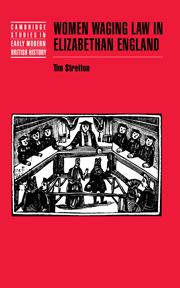Book contents
- Frontmatter
- Contents
- Lists of maps and figures
- List of tables
- Preface
- Notes on the text
- Abbreviations
- 1 Introduction
- 2 Women, legal rights and law courts
- 3 Female litigants and the culture of litigation
- 4 The Court of Requests
- 5 Unmarried women and widows
- 6 Married women in Requests
- 7 Freebench, custom and equity
- 8 Pleading strategies in Requests
- 9 Women waging law
- Glossary
- Bibliography
- Index
- Cambridge Studies in Early Modern British History
6 - Married women in Requests
Published online by Cambridge University Press: 11 November 2009
- Frontmatter
- Contents
- Lists of maps and figures
- List of tables
- Preface
- Notes on the text
- Abbreviations
- 1 Introduction
- 2 Women, legal rights and law courts
- 3 Female litigants and the culture of litigation
- 4 The Court of Requests
- 5 Unmarried women and widows
- 6 Married women in Requests
- 7 Freebench, custom and equity
- 8 Pleading strategies in Requests
- 9 Women waging law
- Glossary
- Bibliography
- Index
- Cambridge Studies in Early Modern British History
Summary
You [Mr Bumble] are the more guilty of the two, in the eye of the law; for the law supposes that your wife acts under your direction.'
‘If the law supposes that,’ said Mr Bumble, squeezing his hat emphatically in both hands, ‘the law is a ass – a idiot. If that's the eye of the law, the law is a bachelor. (Charles Dickens Oliver Twist (1838))
Elizabethan moralists encouraged unmarried women and widows to seek legal assistance from male kin or confidants, but the common law demanded that married women leave their legal affairs to their husbands. As described in chapter 2 above, the doctrine of coverture stripped married women of their legal entities and independence. It did not, however, remove all of their rights or all of their obligations. Moreover, while coverture theoretically barred married women from appearing in court alone, it did not bar them altogether, and the single largest grouping of women who involved themselves in Requests actions were married women appearing with their husbands. A far smaller, but more intriguing, group of women were the select band of wives who defied the rules and succeeded in suing their own husbands. Their experiences provide further evidence that the Masters recognised that women's particular legal status could sometimes require particular legal and equitable attention and assistance. However, before turning to examine married women as a class of litigant it is necessary to gain a fuller understanding of the theory and practical application of the doctrine of coverture.
- Type
- Chapter
- Information
- Women Waging Law in Elizabethan England , pp. 129 - 154Publisher: Cambridge University PressPrint publication year: 1998

